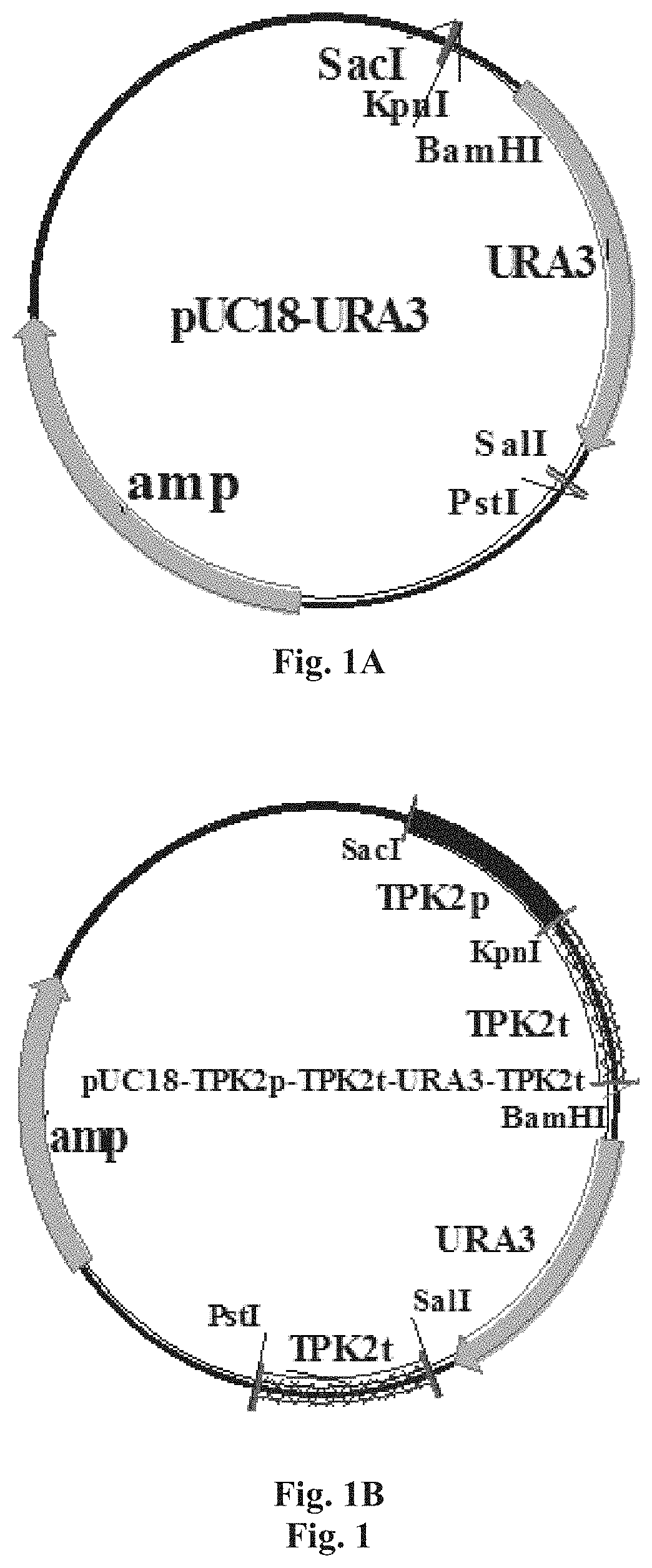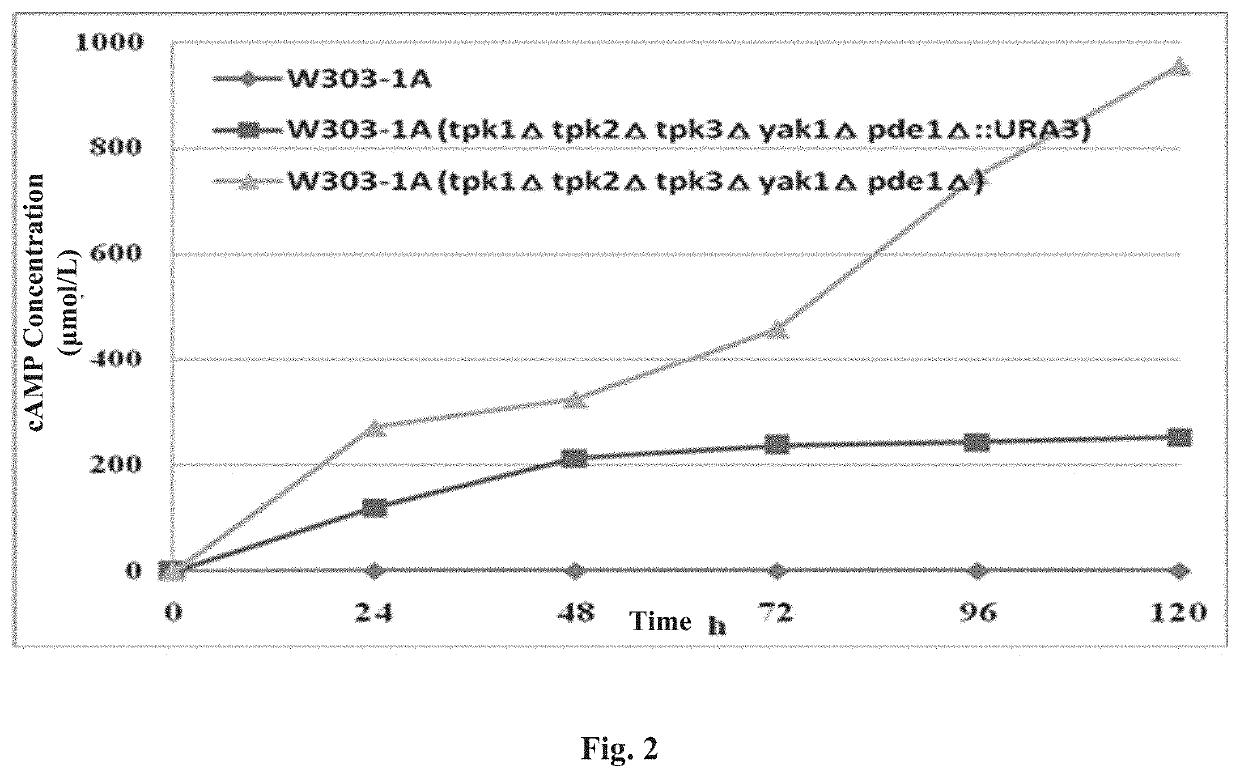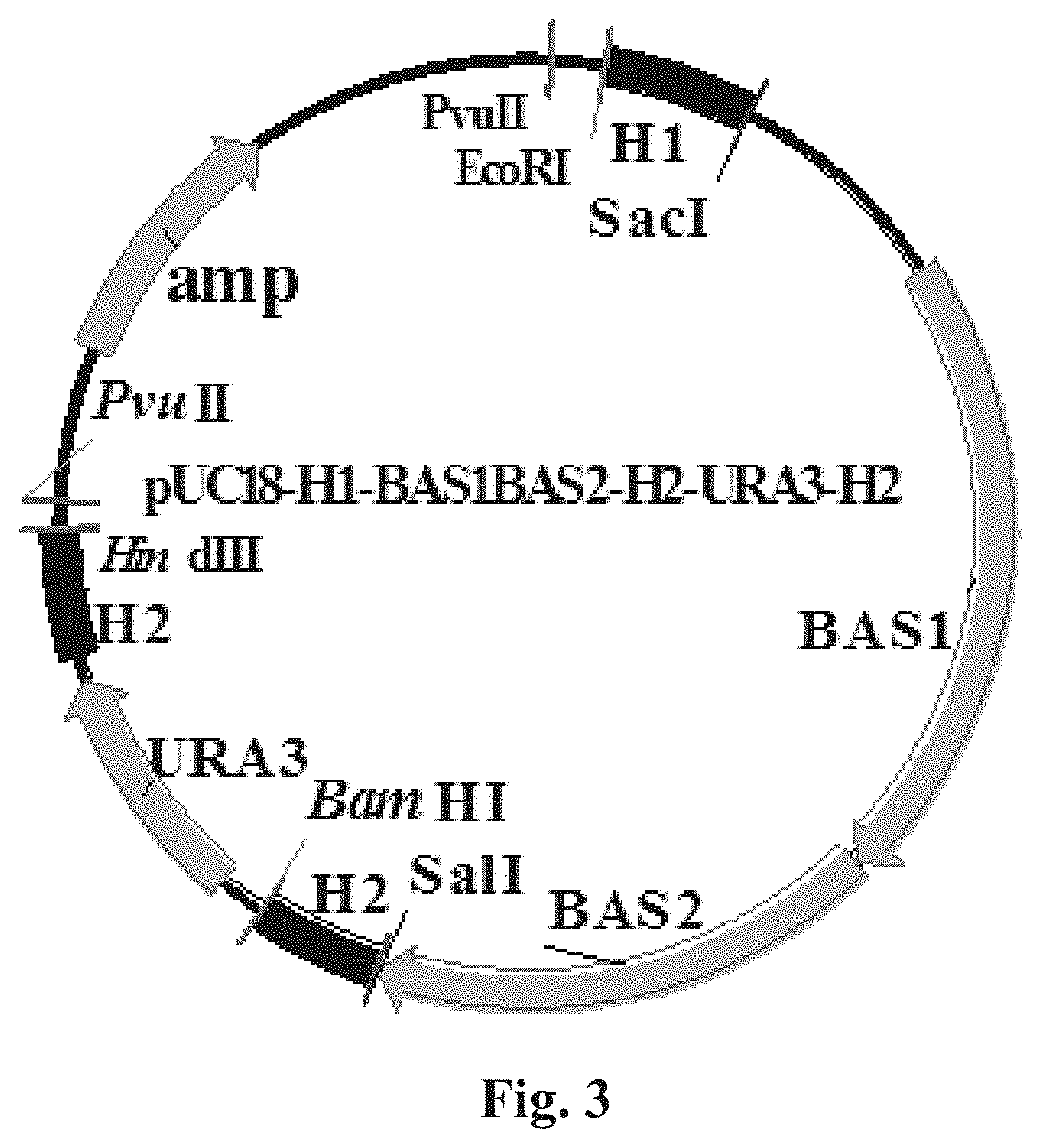High camp yielding yeast strain and use thereof
a high-camp yielding, yeast technology, applied in the field of genetic engineering and microbial fermentation, can solve the problems of serious environmental pollution, complex operation, high cost of reagents involved, etc., and achieve the effect of low nutrient requirement, easy culture, and suitable for large-scale fermentation production
- Summary
- Abstract
- Description
- Claims
- Application Information
AI Technical Summary
Benefits of technology
Problems solved by technology
Method used
Image
Examples
example 1
ion of TPK2 Gene-Deleted Yeast Strain
[0094]Using the homologous recombination double-exchange mechanism to delete the TPK2 gene on the yeast chromosome, the plasmid pUC18-TPK2p-TPK2t-UR43-TPK2t for deletion was firstly constructed. This plasmid was digested to be linearized and transformed into yeast competent cells, and URA3 was used as a selectable marker gene for screening to obtain the yeast strain tpk2Δ::URA3 obtained by double-exchange using TPK2p and TPK2t downstream of URA3 as the left and right homology arms, respectively; and the 5′-FOA plate was used for screening to obtain the yeast strain tpk2Δ in which the URA3 gene was ejected due to the recombination between two TPK2t sequences on the left and right sides of the URA3 in the tpk2Δ::URA3 chromosome.
[0095]The primers for construction and identification are shown in Table 2, and the schematic diagram is shown in FIG. 1.
[0096]I. Construction of pUC18-TPK2p-TPK2t-URA3-TPK2t
[0097]The construction of this plasmid involves fo...
example 2
ion of TPK1 or TPK3 Gene-Deleted Yeast Strain
[0109]1. Construction of W303-1A (tpk1Δ)
[0110]Construction of the plasmid pUC18-TPK1p-TPK1t-URA3-TPK1t for TPK1 gene deletion: the plasmid pUC18-TPK1p-TPK1t-URA3-TPK1t was constructed based on the (1) pUC18-URA3 plasmid in Example 1 by a process identical to the process for obtaining pUC18-TPK2p-TPK2t-URA3-TPK2t by steps (2), (3) and (4) in Example 1. When the primer pair forward and reverse primers P9 and P10 of which the sequences are shown in SEQ ID No. 9 and SEQ ID No. 10 in Table 2 were used to amplify TPK1t, the product was 516 bp long; and when the primer pair forward and reverse primers P11 and P12 of which the sequences are shown in SEQ ID No. 11 and SEQ ID No. 12 in Table 2 were used for amplifying TPK1p, the product was 572 bp long.
[0111]The plasmid pUC18-TPK1p-TPK1 t-URA3-TPK1t was digested with Sac I and Psi I to obtain a linearized DNA fragment TPK1p-TPK1t-URA3-TPK1t; and the W303-1A strain competent cells were transformed, ...
example 3
ion of YAK1 Gene-Deleted Yeast Strain
[0116]Construction of plasmid for YAK1 gene deletion: the plasmid pUC18-YAK1p-YAK1t-URA3-YAK1t was constructed based on the (1) pUC18-URA3 plasmid in Example 1 by a process identical to the process for obtaining pUC18-TPK1p-TPK1t-URA3-TPK1t by steps (2), (3) and (4) in Example 1. When the primer pair forward and reverse primers P21 and P22 of which the sequences are shown in SEQ ID No. 21 and SEQ ID No. 22 in Table 2 was used to amplify YAK1t, the product was 506 bp long; and when the primer pair forward and reverse primers P23 and P24 of which the sequences are shown in SEQ ID No. 23 and SEQ ID No. 24 in Table 2 was used to amplify YAK p, the product was 504 bp long.
[0117]Construction of YAK1 gene-deleted strain: the plasmid pUC18-YAK1p-YAK1t-URA3-YAK1t was digested with Sac I and Pst I to obtain a linearized DNA fragment YAK1p-YAK1t-URA3-YAK1t; and the W303-1A strain competent cells were transformed, and screening and identification were carrie...
PUM
| Property | Measurement | Unit |
|---|---|---|
| concentration | aaaaa | aaaaa |
| pore size | aaaaa | aaaaa |
| pore size | aaaaa | aaaaa |
Abstract
Description
Claims
Application Information
 Login to View More
Login to View More - R&D
- Intellectual Property
- Life Sciences
- Materials
- Tech Scout
- Unparalleled Data Quality
- Higher Quality Content
- 60% Fewer Hallucinations
Browse by: Latest US Patents, China's latest patents, Technical Efficacy Thesaurus, Application Domain, Technology Topic, Popular Technical Reports.
© 2025 PatSnap. All rights reserved.Legal|Privacy policy|Modern Slavery Act Transparency Statement|Sitemap|About US| Contact US: help@patsnap.com



